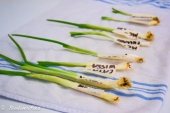


Peter Ellis wrote:Linsey [sic], the point about seeds is exactly that seeds are not how apples are propgated. So it was disingenuous for them to say that the chaacteristic won't be carried on through seed. To then say that apples are grafted, but say nothing about the traits being carried through the rootstock systemically - well, that is further misrepresentation.
I don't know whether grafting this stock onto a tree with three other varieties is going to pass those traits on to the other grafted varieties, but that is a real concern that I would like to see addressed.
As to out competing versus regulation - that does not help if something gets out that contaminates your entire ndustry.
The very real problem with these developments is that they can have unforeseen and unintended consequences. Some times it is not even that the consequences are unforeseen so much as that the people pushing a product simply do not think about possible downsides. There need to be adequate regulatory safeguards to prevent introduction of GMOs that have negative envirnmental impacts. I am skeptical as to whether they are in place.
Another thought. Our governments are coming up with regulations that bar "invasive species", Entirely natural organisms, often quite beneficial, but not from the local area are being targeted for destruction. Yet GMO corn, that freely contaminates open pollinated corn, destroying cultivars right and left, is legally protected and the injured farmer has no right to protection from this truly invasive species.
Peter Ellis wrote: To the best of my understanding, this is something that has never been true with plant grafting before. Grafting Macintosh scion wood onto crab apple root stock would not systemically convert the crab apple to express the macintosh genetics.



 , and so far I've written two pieces about the arctic apple you can check out.
, and so far I've written two pieces about the arctic apple you can check out.

Jennifer Smith wrote:I have some onions for you! They are of the walking or Egyptian type. I got then from a friend who was still growing them on the family farm that has been the family farm for generations. Goats love them and they are sweet and yummy in fried taters. And boy do they multiply with just a little effort.

cv. ‘Catawissa’: “A Catawissa, Pennsylvania, nurseryman by the name of F. F. Merceron (little is known about this individual) engaged in improving the tree onion for commercial purposes. His strains are somewhat different from the others because they send up topsets from topsets, creating the image of plants growing out of plants. He developed three distinct strains of tree onions, a red variety (which I have), a white, and a yellow. Alexander Watson mentioned these strains in passing in his American Home Garden (1859, 159), noting that by then the onions were already being sent in large quantities to northern markets from Bermuda and the South.” Read More




